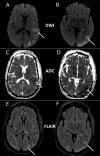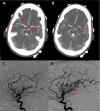Reversible cerebral vasoconstriction syndrome (RCVS) caused by over-the-counter calcium supplement ingestion
- PMID: 33509852
- PMCID: PMC7845714
- DOI: 10.1136/bcr-2019-233877
Reversible cerebral vasoconstriction syndrome (RCVS) caused by over-the-counter calcium supplement ingestion
Abstract
A 59-year-old woman was found unresponsive at home. Initial neurologic examination revealed aphasia and right-sided weakness. Laboratory results demonstrated a serum calcium level of 17.3 mg/dL (corrected serum calcium for albumin concentration was 16.8 mg/dL). Extensive workup for intrinsic aetiology of hypercalcemia was unrevealing. Further discussion with family members and investigation of the patient's home for over-the-counter medications and herbal supplements revealed chronic ingestion of calcium carbonate tablets. CT angiogram of the brain revealed multifocal intracranial vascular segmental narrowing, which resolved on a follow-up cerebral angiogram done 2 days later. These findings were consistent with reversible cerebral vasoconstriction syndrome.Appropriate blood pressure control with parenteral agents, calcium channel blockade with nimodipine and supportive care therapies resulted in significant improvement in neurologic status. By discharge, patient had near-complete resolution of neurologic symptoms.
Keywords: adult intensive care; drugs and medicines; drugs: CNS (not psychiatric); neurological injury; stroke.
© BMJ Publishing Group Limited 2020. No commercial re-use. See rights and permissions. Published by BMJ.
Conflict of interest statement
Competing interests: None declared.
Figures


Similar articles
-
Chemical angioplasty for medically refractory reversible cerebral vasoconstriction syndrome.Br J Neurosurg. 2018 Aug;32(4):431-435. doi: 10.1080/02688697.2018.1479512. Epub 2018 Sep 12. Br J Neurosurg. 2018. PMID: 30207193
-
Reversible segmental cerebral vasoconstriction (Call-Fleming syndrome): are calcium channel inhibitors a potential treatment option?Cephalalgia. 2003 Apr;23(3):218-22. doi: 10.1046/j.1468-2982.2003.00507.x. Cephalalgia. 2003. PMID: 12662190
-
Intra-arterial milrinone for reversible cerebral vasoconstriction syndrome.Headache. 2009 Jan;49(1):142-5. doi: 10.1111/j.1526-4610.2008.01211.x. Epub 2008 Jul 21. Headache. 2009. PMID: 18647181
-
Reversible cerebral vasoconstriction syndrome (RCVS) in antiphospholipid antibody syndrome (APLA): the role of centrally acting vasodilators. Case series and review of literature.Clin Rheumatol. 2014 Dec;33(12):1829-33. doi: 10.1007/s10067-013-2434-9. Epub 2013 Nov 26. Clin Rheumatol. 2014. PMID: 24277114 Review.
-
A systemic lupus erythematosus patient with thunderclap headache: reversible cerebral vasoconstriction syndrome.Lupus. 2019 Jun;28(7):898-902. doi: 10.1177/0961203319845485. Epub 2019 May 1. Lupus. 2019. PMID: 31042127 Review.
Cited by
-
Treatment-Related Reversible Cerebral Vasoconstriction Syndrome.J Clin Med. 2024 Oct 4;13(19):5930. doi: 10.3390/jcm13195930. J Clin Med. 2024. PMID: 39407990 Free PMC article. Review.
-
Reversible cerebral vasoconstriction syndrome due to teprotumumab: two case reports.Oxf Med Case Reports. 2024 Aug 6;2024(8):omae085. doi: 10.1093/omcr/omae085. eCollection 2024 Aug. Oxf Med Case Reports. 2024. PMID: 39119013 Free PMC article.
References
Publication types
MeSH terms
Substances
Grants and funding
LinkOut - more resources
Full Text Sources
Other Literature Sources
